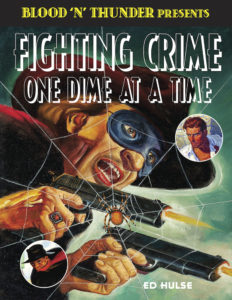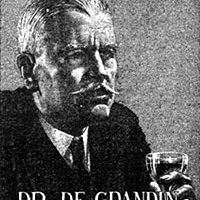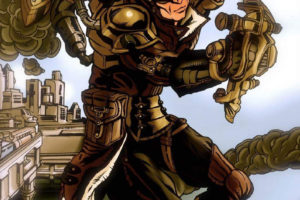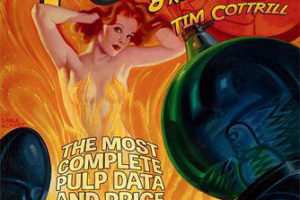 Ed Hulse and his Murania Press have put out a third Blood ‘n’ Thunder Presents volume, this time focused on the pulp heroes: Fighting Crime One Dime at a Time.
Ed Hulse and his Murania Press have put out a third Blood ‘n’ Thunder Presents volume, this time focused on the pulp heroes: Fighting Crime One Dime at a Time.
(And, yes, there is a second volume in the series, The Penny-a-Word Brigade. I just haven’t gotten that one, and when I do I’ll post a review.)
As a pulp-hero fan, I recommend this volume, which has a whole set of articles on pulp heroes, all reprinted from previous issues of Blood ‘n’ Thunder. We also get a couple of pulp-hero comic stories from the golden age. Now, these are not your standard overview articles (though there are a couple of those). Several delve into some interesting topics, some have helped me with some of my postings here, and all are written by several pulp historians.
We get articles on many of the major heroes, and a couple of obscure ones.
Larry Latham kicks it off with a great article looking at the transition from story papers and dime novels to pulp magazines. This didn’t happen overnight. If you’re not too clear as to what story papers and dime novels are, what form they took, and how important they are in the development and delivery of popular fiction, this article will help you out.
Joe Rainone takes a look at some possible earlier inspirations for The Shadow, bringing up a couple some may have heard of, such as “The Shadow of Wall Street,” but focuses on the earlier story-paper character, “The Man in the Black Cloak.” This series has been reprinted and I need to see if I can find and review it.
Nick Carter is an early and important dime-novel hero I have posted on, and John Coryell provides a good overview of the character.
Ed Hulse provides two overview articles on pulp heroes. The first looks at Street & Smith’s pulp-hero mags for The Shadow, Doc Savage, The Avenger, and all the rest: Bill Barnes, Pete Rice, Nick Carter, The Whisperer, The Wizard, etc.
The second article looks at the pulp heroes from Thrilling, Popular, Ace, and Fiction House.
Will Murray has two articles. The first looks at the launch date for Doc Savage and how it doesn’t fit in with when Street & Smith usually launches new magazines, and speculates why. His second article is also a little esoteric. It looks at the matter of a “missing” Spider story, and goes into an background of pulp writer “Wayne Rogers,” who also wrote Operator #5 and who had a bit of a checkered background.
Some may not be aware that The Lone Ranger, the hero of radio, TV, and other media also had a short-lived pulp magazine. Albert Tonik provides a detailed look at this magazine, including the contents of each issue. It’s interesting to see how the Ranger is shown on the cover as compared to how most of us imagine him from the TV show.
An interesting survey article looks at the 20 most underrated Shadow novels.
Mark Trost wrote the rest of the articles. The first looks at several “disposable” pulp heroes, one-shot characters who populated magazines like Strange Detective Mysteries and Detective Tales. These characters had various psychological issues, taking on multiple identities, disguises, and the like. One could image that some of them could have made interesting serial characters. Other than Paul Ernst‘s The Wraith, I’m not sure if any of the ones mentioned have been reprinted. Yet.
Another article is a take on how not to write a pulp-hero novel, using an outline for a Phantom Detective story as an example.
We then get two articles on pulp-hero comics. The first looks at a very short-lived comic series that ran in Thrilling Wonder Stories, which starred a Flash Gordon-like character like Zarnak. Apparently readers hated the series, and it only last eight three-page segments. One segment was reprinted in Pulp Adventures #22, and I now wish they’d reprint the rest so we can see if it’s as bad as people thought.
The next looks at a trio of character who appeared in Ace Comics that were clearly copied from prior Ace pulp heroes! The Moon Man became The Raven; Secret Agent X became X the Phantom Fed; and the first adventure of Captain Hazzard was turned into the first adventure of Flash Lightning. I’m still wondering if the other Phantom Fed and Raven stories also copied from further stories of the pulp heroes.
And finally, in an article co-written with Hulse, Trost takes a look at the twilight of the pulp heroes: the final issues of Doc, The Shadow, the Phantom Detective, and the Black Bat, along with the last hurrah (?) of Captain Zero.
In an appendix, we get two pulp-hero comic stories with an intro by Hulse. First up is the first Mask story. The owl-inspired Mask is just the Black Bat renamed, due to the agreement with DC Comics. But if you’ve read the first Black Bat story, you will see how it matches up. I still wonder if this was true with the rest. Next up is the only Major Mars story. Major Mars is just Captain Future renamed because Nedor already had a Captain Future comic-book character. This story adapted the first Captain Future story, “The Space Emperor.” But as with other comics, they only used the character of Grag the robot, and dropped the other supporting characters from Captain Future.
As always, an excellent book from Murania Press. Get this one. I hope to get the second volume at some time, and I look forward to what 2018 will bring in this series of volumes.



